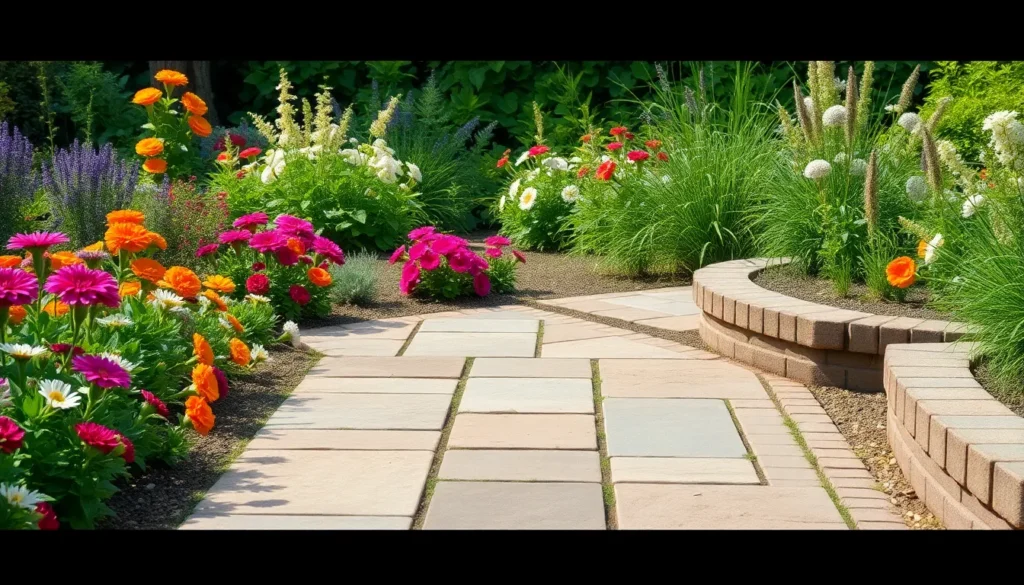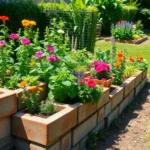Transform your outdoor space into a stunning oasis with the right garden paving choices. We’ve all dreamed of that perfect backyard where function meets beauty – and selecting the ideal paving material is your first step toward making that vision reality.
Whether you’re working with a sprawling industry or a cozy courtyard we’ll guide you through innovative paving answers that enhance both aesthetics and practicality. From timeless natural stone to modern concrete alternatives each option offers unique benefits that can complement your garden’s personality and your lifestyle needs.
Ready to discover paving ideas that’ll make your neighbors stop and stare? We’re about to explore creative approaches that range from budget-friendly DIY projects to luxurious statement pieces. Your dream garden is closer than you think – and it all starts with choosing the perfect foundation beneath your feet.
Classic Brick Paving for Timeless Garden Appeal
Brick paving creates an enduring foundation that complements both traditional and contemporary garden designs. We’ve found that brick’s natural warmth and texture provide the perfect backdrop for vibrant plantings while maintaining structural integrity for decades.
Herringbone Pattern Layout
Herringbone arrangements deliver maximum stability through interlocking brick placement at 45-degree angles. We recommend this pattern for high-traffic areas like main walkways and patio spaces where durability matters most. The zigzag design distributes weight evenly across the surface, preventing individual bricks from shifting or settling over time.
Installation requires precise measurements to maintain consistent spacing between each brick unit. Professional installers typically achieve the best results, though experienced DIY gardeners can tackle smaller projects with proper planning. We’ve observed that herringbone patterns work exceptionally well with standard red clay bricks, weathered reclaimed bricks, and modern concrete brick alternatives.
Running Bond Design
Running bond layouts create clean lines using a simple offset pattern that resembles traditional masonry walls. Each brick row starts at the halfway point of the bricks below, forming a classic staggered appearance that’s both elegant and practical. We find this design particularly effective for garden paths and borders where you want visual continuity without overwhelming complexity.
The pattern requires fewer cuts than herringbone installations, making it more budget friendly for larger areas. Drainage improves naturally through the consistent joint spacing, which prevents water pooling during heavy rainfall. We suggest using this layout when connecting different garden zones, as the linear flow guides visitors naturally through outdoor spaces.
Basket Weave Configuration
Basket weave patterns alternate brick orientations to create distinctive square modules throughout your paved area. Two or three bricks run horizontally, followed by the same number running vertically, producing a woven textile appearance that adds visual interest to patios and seating areas. We’ve seen this design work beautifully in formal garden settings where symmetry and craftsmanship take center stage.
The modular nature allows for creative color combinations using different brick types within the same installation. Maintenance becomes simpler since individual modules can be repaired without disturbing the entire surface. We recommend basket weave configurations for enclosed courtyards and intimate garden rooms where the detailed pattern can be appreciated up close.
Natural Stone Paving for Rustic Garden Charm
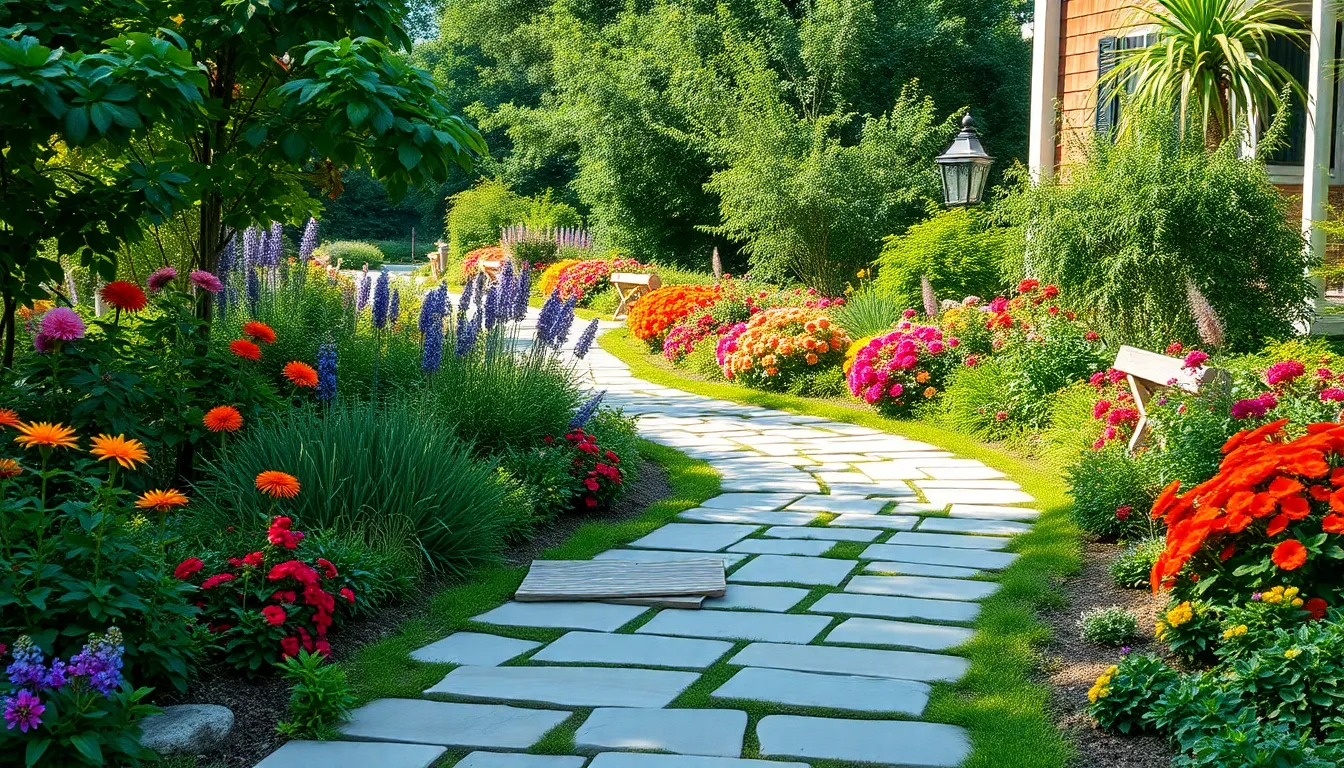
Natural stone paving brings timeless beauty to garden spaces while creating that coveted rustic atmosphere. We’ll explore three exceptional natural stone options that can transform any outdoor area into a charming retreat.
Flagstone Installation Options
Flagstone offers incredible versatility for creating unique garden surfaces that capture rustic elegance. Random layout patterns allow us to embrace the natural irregularities of stone pieces, creating organic pathways that meander beautifully through garden beds. Grid format installations provide more structured designs while maintaining the authentic stone texture and character.
Different colors and textures make flagstone suitable for various garden styles, from cottage gardens to contemporary landscapes. Installation flexibility means we can use flagstone for both patios and pathways, adapting the stone size and placement to match our exact design vision.
Slate Paving Techniques
Slate paving delivers exceptional durability paired with a sleek, sophisticated appearance that ages gracefully. Symmetrical patterns create modern outdoor spaces while maintaining the natural stone’s inherent character and charm. Grid arrangements work particularly well for patios where we want clean lines and geometric precision.
Slip resistant properties make slate an ideal choice for high traffic areas and spaces prone to moisture. Pathway applications showcase slate’s ability to guide visitors through garden spaces while providing safe, stable footing in all weather conditions.
Limestone Garden Pathways
Limestone pathways add timeless elegance to any garden setting with their warm, inviting appearance. Rustic limestone pavers feature hand dressed edges and antiqued surfaces that perfectly evoke English country garden aesthetics. Meandering path designs allow us to create romantic walkways that curve naturally around plantings and garden features.
Straight walkway installations offer more formal approaches while still maintaining limestone’s inherent charm and durability. Various finishes range from smooth contemporary looks to weathered rustic textures, giving us complete customization control for different garden themes and architectural styles.
Modern Concrete Paving Solutions

Modern concrete paving offers endless possibilities for creating contemporary garden spaces. We’ll explore innovative concrete techniques that combine durability with striking visual appeal.
Stamped Concrete Designs
Stamped concrete transforms ordinary surfaces into stunning replicas of natural materials. We can create textured looks that mimic natural stone or brick textures, adding remarkable depth and visual interest to garden paths. Pattern designs like herringbone or ashlar bring traditional elegance with a modern twist to outdoor spaces.
Professional stamping techniques allow us to achieve intricate details that rival expensive natural materials. Installation involves pouring concrete and pressing specialized stamps into the surface before it fully cures. Maintenance remains minimal compared to authentic stone or brick alternatives.
Exposed Aggregate Finishes
Exposed aggregate finishes reveal the beauty hidden within concrete by showcasing embedded materials like pebbles or decorative stones. We achieve this natural look through specialized techniques that wash away the surface cement, exposing the underlying aggregate materials. Durability stands out as a key benefit, making these finishes ideal for high traffic areas where longevity matters most.
Surface preparation involves careful timing during the concrete curing process. Water washing removes the top layer of cement paste, revealing the colorful stones beneath. Weather resistance and slip resistance make exposed aggregate particularly suitable for pool decks and walkways.
Colored Concrete Applications
Colored concrete adds vibrant personality to garden designs through various application methods. We can incorporate colorful accents using either integrally colored concrete or surface applied stains for dramatic effects. Themed gardens benefit from coordinated color schemes, such as using earthy tones for natural garden settings or bold hues for contemporary spaces.
Integral coloring mixes pigments directly into the concrete before pouring, ensuring consistent color throughout the material. Surface staining offers more flexibility, allowing us to create variegated effects and artistic patterns. Both methods provide long lasting results that won’t fade or chip like painted surfaces.
Gravel and Decomposed Granite Pathways
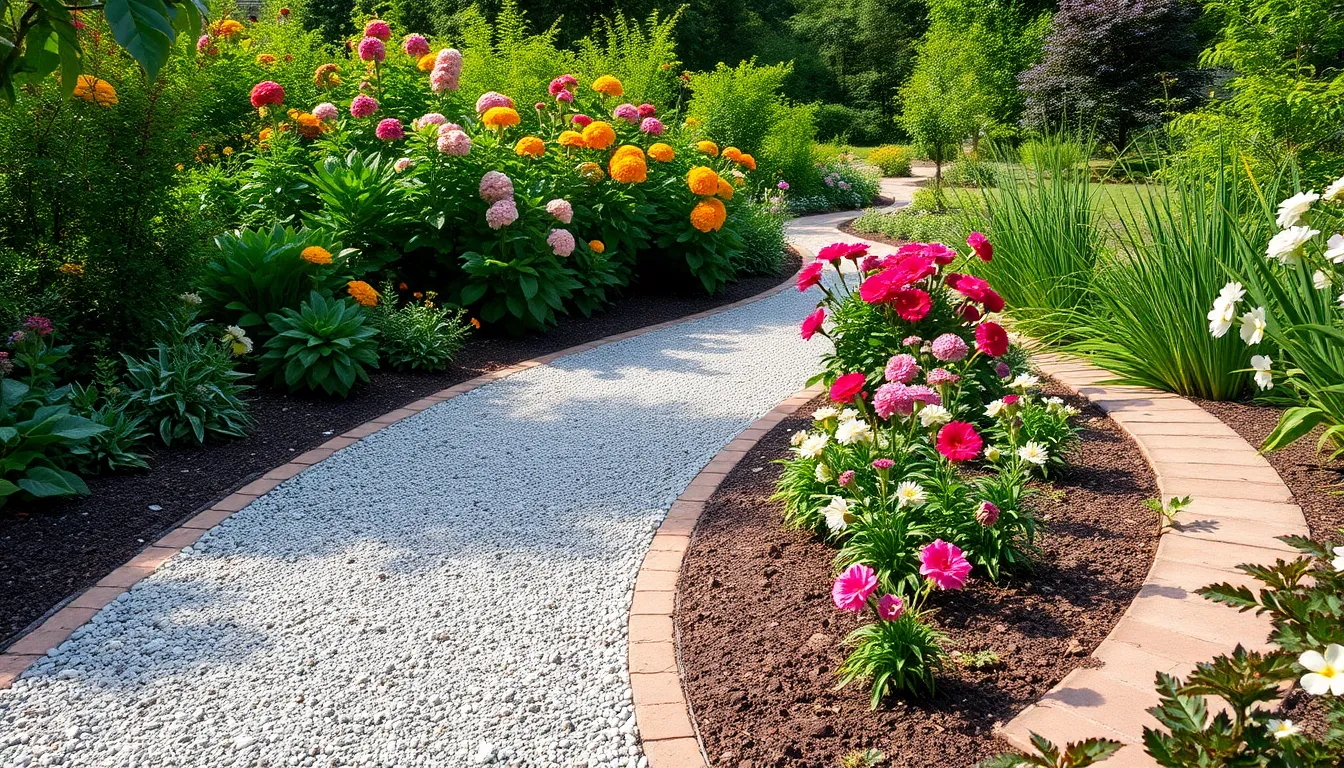
Moving beyond traditional paving materials, we explore the natural elegance and practical benefits of loose aggregate pathways. These versatile options offer both aesthetic appeal and functional advantages for any garden paving project.
Permeable Paving Benefits
Water drainage becomes remarkably efficient with gravel and decomposed granite surfaces, as these materials naturally allow water to pass through and reduce stormwater runoff. Our experience shows that permeable pathways significantly alleviate pressure on existing drainage systems while preventing costly water accumulation issues.
Environmental benefits extend far beyond simple drainage, as these pathways actively help recharge groundwater supplies and reduce the urban heat island effect in our outdoor spaces. We’ve observed that decomposed granite particularly excels at maintaining stable moisture levels while supporting natural water cycles.
Maintenance advantages become apparent through reduced puddling and ice formation during winter months, making these surfaces safer and more practical year-round. Gravel pathways offer natural flexibility that accommodates ground movement without cracking, unlike rigid paving materials.
Border and Edging Options
Brick borders provide our gravel and granite pathways with traditional definition, creating clean lines that prevent material migration while maintaining classic garden aesthetics. We recommend standard clay bricks for their durability and timeless appearance that complements various garden styles.
Paver edging offers enhanced design flexibility through diverse colors, shapes, and textures that can transform simple pathways into striking garden features. Modern pavers work exceptionally well with decomposed granite, creating sophisticated transitions between different garden zones.
Natural stone borders deliver rustic authenticity that perfectly complements loose aggregate surfaces, with options like fieldstone and flagstone providing organic edge definition. We’ve found that natural stone edging creates seamless visual flow between pathways and surrounding industry elements.
Maintenance Requirements
Cleaning protocols for aggregate pathways involve regular sweeping to remove debris and occasional raking to maintain even surface distribution. We recommend monthly maintenance to prevent compaction and ensure optimal drainage performance throughout the seasons.
Vegetation control requires consistent attention to prevent weeds from establishing roots within gravel or granite surfaces. Strategic application of industry fabric beneath pathways significantly reduces maintenance time while maintaining the natural permeability benefits.
Surface refreshing becomes necessary every 2-3 years as materials naturally compact and migrate, requiring additional aggregate to maintain proper depth and appearance. Decomposed granite typically needs more frequent refreshing than gravel due to its finer particle size and binding characteristics.
Interlocking Paver Systems for Easy Installation
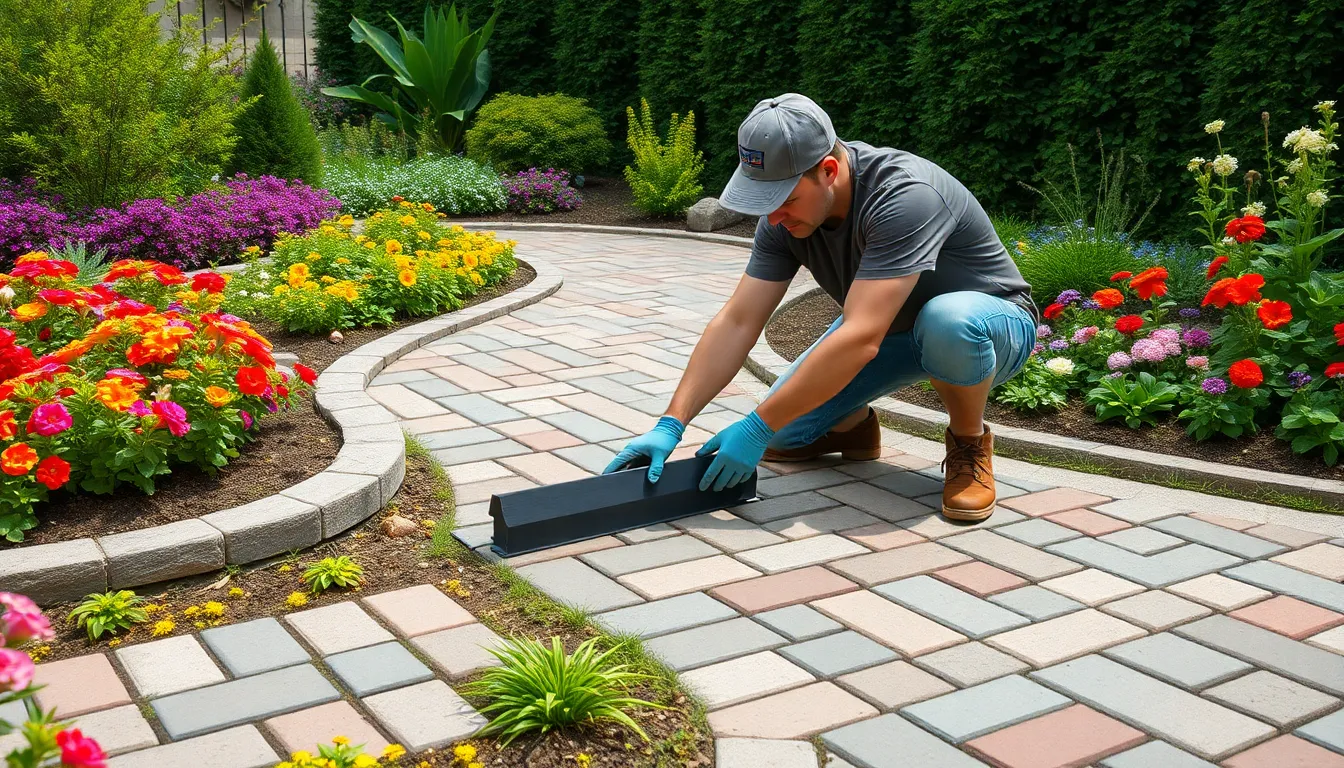
Interlocking paver systems revolutionize garden paving by eliminating the need for mortar while providing exceptional durability. These specially designed pavers fit together seamlessly, creating a stable surface that’s perfect for both experienced landscapers and first-time DIY enthusiasts.
Modular Design Advantages
Flexibility tops our list of modular paver benefits since these systems allow us to easily rearrange or replace individual pieces when needed. Drainage naturally occurs through the joints between pavers, preventing water accumulation that can damage traditional solid surfaces. Aesthetic variety flourishes with modular designs as we can incorporate multiple colors, textures, and patterns to create truly unique outdoor spaces.
Adaptability makes modular pavers ideal for gardens that evolve over time, whether we’re expanding pathways or changing design themes. Maintenance becomes simpler since damaged pavers can be replaced individually without disturbing the entire installation. Cost effectiveness emerges from the ability to purchase additional pavers later to extend or modify existing layouts.
Pattern Variation Options
Herringbone patterns deliver both strength and visual appeal, making them our top choice for high-traffic garden areas. Basketweave configurations add elegance and sophistication to formal garden settings with their classic interwoven appearance. Offset diamond patterns create ever-changing, modern looks that complement contemporary industry designs.
Running bond layouts provide clean, streamlined aesthetics perfect for minimalist garden themes. Circular patterns establish focal points around garden features like fountains or planters. Random patterns offer natural, organic appearances that blend seamlessly with informal garden styles.
DIY Installation Tips
Preparation starts with ensuring the ground is completely level and properly compacted before laying any pavers. Base installation requires using compacted gravel or sand to create a stable foundation that prevents settling over time. Sand filling secures the gaps between pavers, locking them in place and preventing movement.
Slope planning ensures proper drainage by creating a slight grade away from structures and toward designated drainage areas. Edge restraints maintain the integrity of the paver system by preventing spreading and maintaining clean borders. Compaction tools help achieve professional results by ensuring each paver sits firmly in its designated position.
Mixed Material Paving Combinations
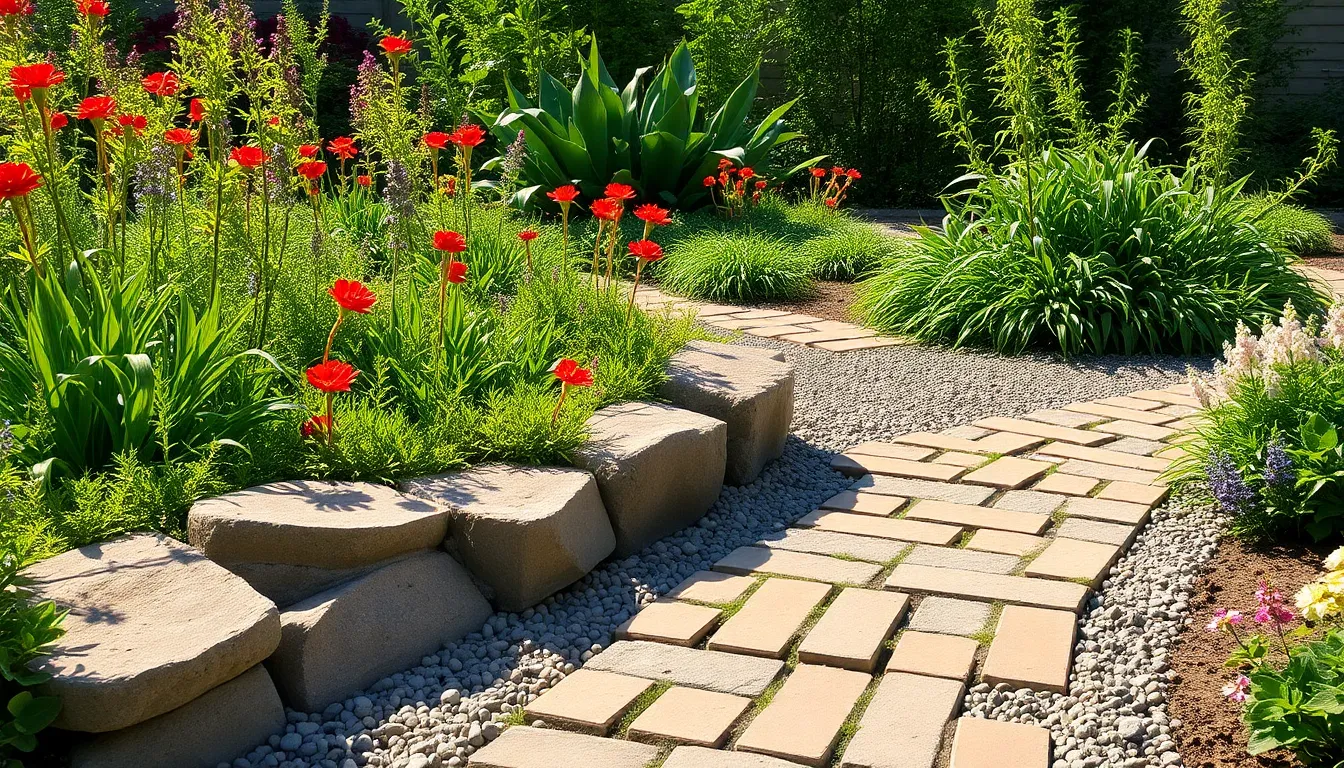
Combining different materials creates visually ever-changing garden paving that balances texture, color, and functionality. We recommend mixing materials with complementary characteristics to achieve harmonious yet interesting designs.
Stone and Gravel Mixtures
Stone and gravel combinations offer exceptional durability while maintaining excellent drainage properties. Large natural stone slabs like flagstone, slate, or granite provide stable stepping surfaces and structural focal points. Coarse gravel fills the gaps between stones, creating an informal rustic texture that softens hard edges and defines clear pathways.
We’ve found this pairing particularly effective because stones handle heavy foot traffic while gravel manages water runoff efficiently. The permeable surface requires minimal maintenance compared to solid paving options. Granite pavers bordered with decorative river rock create stunning visual contrast, while slate stepping stones surrounded by decomposed granite offer a more subtle, cohesive appearance.
Brick and Plant Integration
Brick pavers deliver timeless warmth that complements both traditional and contemporary garden styles perfectly. Plants integrated between brick joints or along borders soften the hardscape while adding vibrant greenery that contrasts beautifully with earthy brick tones. Reclaimed bricks enhance vintage charm and support sustainable landscaping practices.
Ground cover plants like thyme or moss between brick pavers create living joints that release fragrance when stepped on. We recommend selecting plants that tolerate foot traffic and thrive in the exact growing conditions between pavers. Creeping Jenny and Irish moss work exceptionally well in shaded areas, while sedums flourish in sunny locations with minimal water requirements.
Wood and Stone Accents
Wood and stone pairings bring natural warmth to outdoor spaces through contrasting textures and complementary colors. Wooden planks or decking surrounded by stone pavers create layered outdoor environments that serve multiple functions while maintaining aesthetic appeal. The smooth wood texture contrasts beautifully with rough stone surfaces, adding visual depth to garden paving designs.
Teak decking paired with limestone pavers creates sophisticated entertainment areas, while cedar planks combined with fieldstone offer rustic charm. We suggest using weather resistant wood species and ensuring proper drainage around stone borders to prevent moisture damage. This combination works particularly well for defining seating areas, pathways, and transition zones between different garden spaces.
Eco-Friendly Paving Alternatives
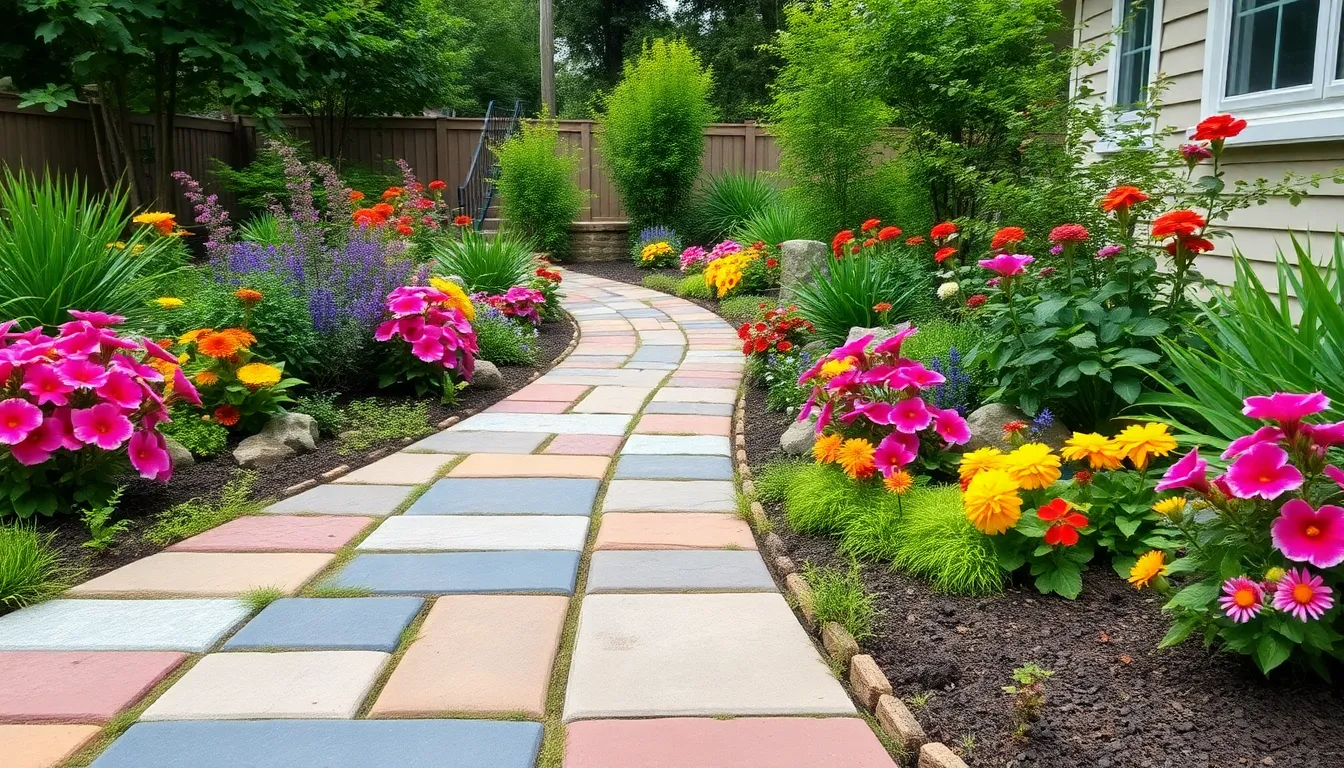
Environmental consciousness meets functional design when we choose sustainable paving answers that protect our planet while creating beautiful outdoor spaces. These alternatives reduce our environmental footprint while delivering the durability and aesthetics we need for our gardens.
Recycled Material Options
Recycled concrete pavers transform construction waste into stunning garden surfaces that rival natural stone in both appearance and strength. These repurposed materials reduce landfill burden while offering various patterns that mimic expensive natural options. Manufacturing recycled concrete pavers requires significantly less energy than producing new materials.
Plastic based permeable pavers like TRUEGRID systems use 100% recycled plastic to create incredibly durable surfaces lasting up to 60 years. UV resistance protects these pavers from sun damage while maintaining their structural integrity. We can achieve 98% permeable surfaces that handle water drainage effectively while supporting vehicles and foot traffic.
Crushed recycled glass creates sparkling pathways that reflect light beautifully throughout our gardens. This material compacts well for stable walking surfaces while allowing water infiltration. Color options range from clear to vibrant blues and greens depending on the source glass.
Living Paver Answers
Open concrete grids merge hardscape functionality with natural vegetation by allowing grass or ground cover to grow within specially designed cells. These systems support biodiversity while maintaining the structural integrity needed for walkways and patios. Water permeates through planted areas naturally.
Porous pavements create living surfaces that blend seamlessly with existing garden landscapes. Plants establish root systems within the paver structure while the concrete framework provides stability. This combination reduces urban heat island effects significantly.
Grass pavers eliminate the stark appearance of traditional concrete by incorporating living elements directly into our paving design. Root systems help stabilize the surface naturally while photosynthesis contributes to air purification. Maintenance involves standard lawn care practices.
Sustainable Installation Methods
Permeable installation techniques minimize soil disturbance while supporting natural water infiltration patterns that reduce erosion and runoff. These methods preserve existing drainage systems and underground ecosystems. Heavy machinery requirements decrease substantially with proper planning.
Local material sourcing cuts transportation emissions significantly when we choose stone, decomposed granite, or mulch from nearby suppliers. Regional materials also complement local architecture and natural landscapes better. Supply chain efficiency improves with shorter distances.
Manual installation approaches reduce fossil fuel consumption for projects involving crushed stone pathways, mulch surfaces, and smaller paver areas. Hand tools accomplish most tasks effectively while allowing precise placement. Labor intensive methods often produce superior results with attention to detail.
Budget-Conscious Garden Paving Ideas
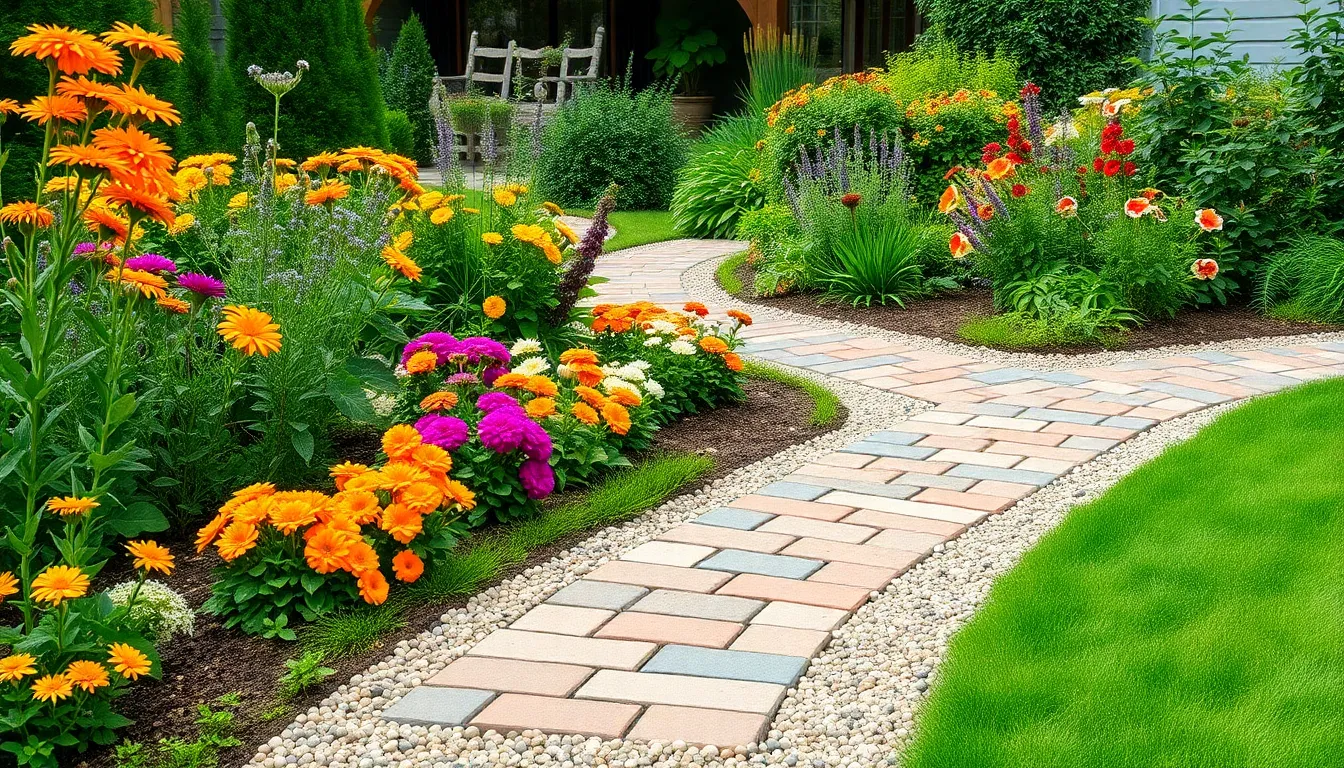
Creating beautiful garden pathways doesn’t require very costly. Smart material selection and strategic planning can deliver stunning results while keeping costs manageable.
Cost-Effective Material Choices
Crushed gravel and decomposed granite top our list of affordable paving materials, offering natural beauty at the lowest cost. We can simply spread these materials over leveled surfaces and compact them for instant pathways that drain well and complement any garden style.
Brick pavers provide exceptional value through their uniform shape and straightforward installation process. Their consistent sizing makes creating attractive patterns like herringbone incredibly simple, while sand filling between joints ensures stability and smooth walking surfaces.
Pea gravel delivers remarkable affordability at $1 to $3 per square foot, making it perfect for budget conscious gardeners. We love how it pairs beautifully with raised garden beds and requires minimal maintenance once installed.
Concrete pavers and slabs offer customization opportunities when we make them ourselves using shaped forms and quick setting concrete mixes. DIY concrete creation allows us to achieve sturdy, personalized surfaces while keeping material costs low.
DIY Installation Savings
Labor costs disappear when we tackle paving projects ourselves using basic tools like shovels, wheelbarrows, trowels, and tampers. Most budget friendly materials require simple spreading, leveling, and compacting techniques that any homeowner can master.
Site preparation becomes manageable with proper planning, as leveling ground and filling gaps with sand or decomposed granite requires no professional expertise. We save hundreds of dollars by handling these foundational steps ourselves.
Installation techniques for materials like brick and gravel involve straightforward processes that build confidence with each completed section. Basic measuring and laying skills develop quickly, making larger projects feel achievable.
Phased Project Planning
Breaking projects into phases allows us to manage expenses over time while creating immediate impact in high priority areas. We recommend starting with smaller sections using affordable materials like gravel or brick, then expanding as budget permits.
Gradual progress through DIY methods eliminates the need for large upfront investments in materials and labor. Each completed phase provides satisfaction and momentum for the next stage of development.
Material mixing strategies optimize both cost and visual appeal by combining gravel paths with brick or concrete gathering areas. This approach spreads expenses across multiple budget cycles while creating sophisticated design transitions throughout our garden spaces.
Creative Pattern and Design Concepts
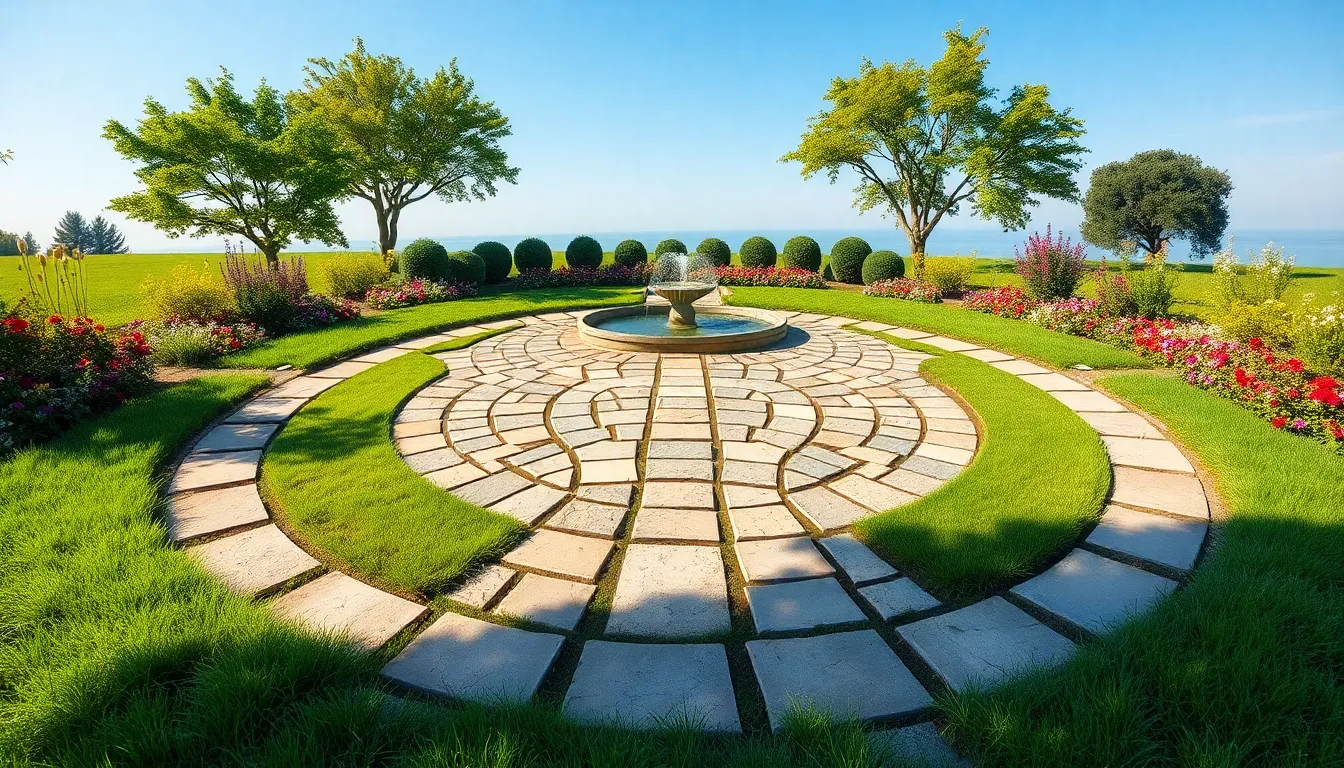
We’ll explore timeless patterns that transform ordinary paving into extraordinary garden features through strategic design choices.
Geometric Layout Ideas
Grid patterns with varying sizes create visual depth by combining different stone dimensions with grass sections throughout your garden space. We recommend alternating large flagstones with smaller pavers to establish rhythm while maintaining structural integrity. Checkerboard designs alternate squares of grass and paving stones for a balanced, chess-like appearance that works beautifully in formal garden settings. These patterns work exceptionally well in courtyards where geometric precision enhances the architectural elements.
Circular arrangements organize stones in concentric rings with grass segments between each layer for harmony and natural flow. We’ve found these patterns particularly effective around tree bases or water features where organic curves complement rigid hardscaping. Herringbone layouts position pavers at 45-degree angles, resembling fish bone structures that provide exceptional stability for high-traffic areas. This pattern distributes weight evenly across the surface, making it ideal for driveways and main walkways.
Curved Pathway Designs
Serpentine pathways guide visitors through garden spaces using gentle curves that create mystery and encourage exploration. We design these routes to reveal new garden views at each turn, maximizing the visual impact of plantings and industry features. Flowing stone arrangements follow natural contours of your industry, working with existing slopes and drainage patterns rather than against them.
Organic curve integration connects different garden zones seamlessly by varying the pathway width and incorporating planted areas within the paved sections. These designs work particularly well when transitioning from formal patio spaces to informal garden areas. Meandering walkways create longer journey experiences in smaller spaces by avoiding straight lines and incorporating gentle S-curves that slow foot traffic naturally.
Focal Point Integration
Circular accent features draw attention to central elements like fountains, sculptures, or specimen plants by arranging paving stones in concentric circles around these key areas. We position these patterns to create natural gathering spots while highlighting your garden’s most important features. Radiating patterns extend outward from focal points using different colored or textured pavers that guide the eye toward important industry elements.
Accent paver placement uses contrasting materials or colors to create visual pathways that lead visitors toward exact garden features or seating areas. These design elements work as subtle directional cues that enhance navigation while maintaining aesthetic appeal. Central medallion designs incorporate decorative paving patterns at pathway intersections or patio centers, creating natural stopping points that encourage visitors to pause and appreciate surrounding garden elements.
Maintenance and Longevity Considerations
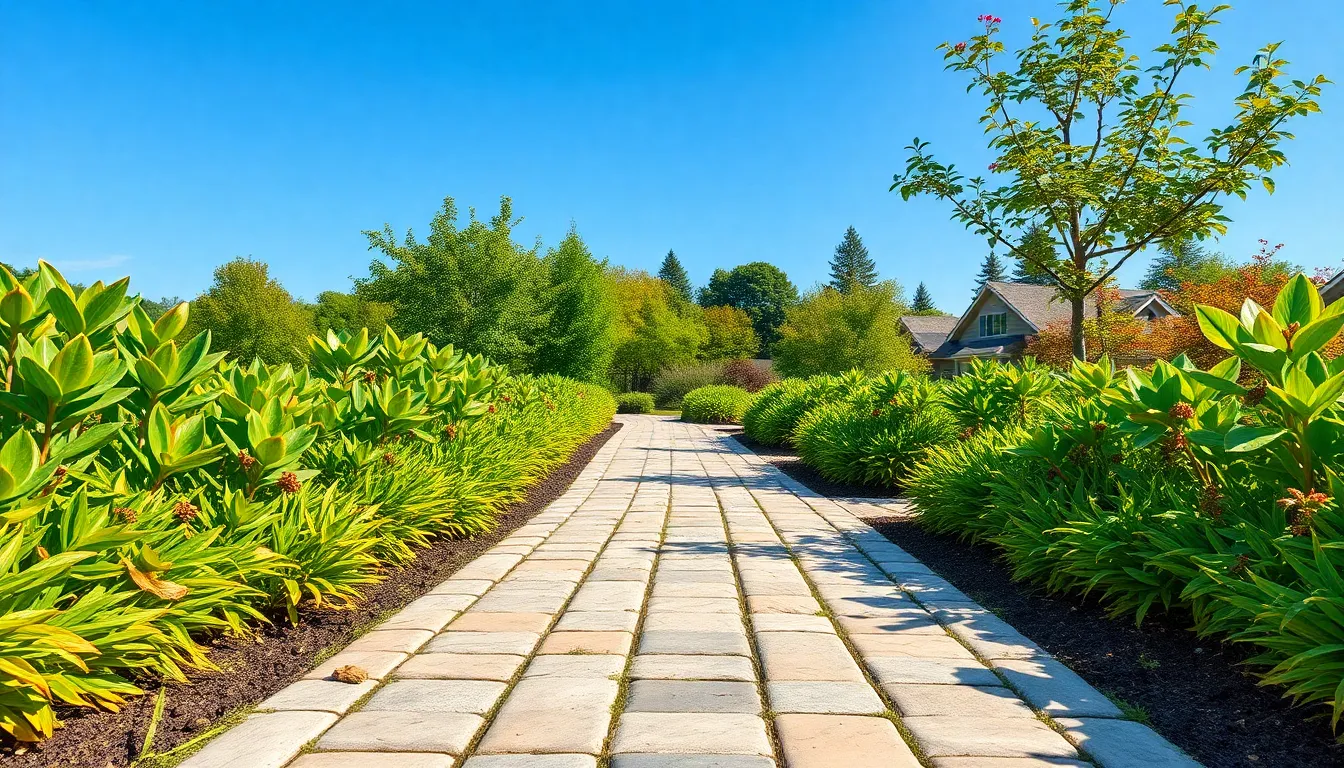
Selecting garden paving materials involves understanding the long-term commitment and care requirements for your investment. Smart planning ensures your pathways remain beautiful and functional for decades to come.
Weather Resistance Factors
Drainage systems form the foundation of weather-resistant paving, preventing water accumulation that leads to erosion and structural damage. We recommend installing proper drainage channels and grout slopes to direct water away from paved surfaces effectively.
Freeze-thaw resistance becomes critical in climates with temperature fluctuations, making natural stone an excellent choice for withstanding seasonal changes. Materials like flagstone and limestone naturally resist cracking when water expands during freezing cycles.
UV protection matters significantly for colored concrete and synthetic materials that can fade under constant sun exposure. Choose UV-resistant sealers and materials specifically designed for your climate zone to maintain vibrant appearances.
Wind resistance affects loose materials like gravel and decomposed granite, requiring proper edging and periodic maintenance to prevent displacement during storms.
Cleaning and Care Requirements
Regular sweeping prevents dirt buildup and maintains the appearance of all paving materials, particularly important for textured surfaces that trap debris. We suggest weekly sweeping for high-traffic areas and monthly maintenance for less used pathways.
Gentle cleaning methods protect your investment by avoiding harsh chemicals like vinegar or salt that can damage natural stone and concrete surfaces. Use pH-neutral cleaners and soft brushes to remove stains without causing surface deterioration.
Stain prevention requires immediate attention to spills, especially on porous materials like natural stone that absorb liquids quickly. Blot rather than scrub fresh stains to prevent them from penetrating deeper into the material.
Seasonal maintenance includes removing leaves and organic matter that can cause staining and promote weed growth in joints and cracks.
Long-Term Durability Planning
Material lifespan expectations vary significantly across paving options, with concrete pavers lasting 20-30 years and natural stone pavers often exceeding 50 years when properly maintained. This longevity data helps justify initial investment costs for premium materials.
Traffic assessment determines the appropriate material thickness and quality needed for your exact usage patterns, whether for light foot traffic or heavy garden equipment access. Commercial-grade pavers work best for areas with frequent wheelbarrow or machinery use.
Sealing schedules require applying paver sealer every one to two years to protect against weathering and maintain water resistance. Mark your calendar for regular sealing to prevent costly repairs from moisture damage.
Weed prevention strategies include using polymeric sand to fill cracks and joints, creating a barrier that prevents weed growth while allowing proper drainage. This proactive approach reduces long-term maintenance requirements and preserves the integrity of your paving installation.
Conclusion
We’ve explored countless paving possibilities to transform your garden into a stunning outdoor retreat. From timeless brick patterns to sustainable eco-friendly alternatives each option offers unique benefits that align with different budgets styles and maintenance preferences.
The key to successful garden paving lies in understanding your exact needs and choosing materials that complement your lifestyle. Whether you’re drawn to natural stone’s elegance gravel pathways’ simplicity or innovative mixed-material combinations the right choice will enhance your outdoor space for years to come.
Remember that proper planning and installation make all the difference in achieving professional results. With careful consideration of drainage weather resistance and long-term maintenance you’ll create beautiful functional pathways that add lasting value to your property.
Frequently Asked Questions
What is the most durable garden paving material?
Natural stone, particularly flagstone and slate, offers exceptional durability and weather resistance. Interlocking concrete pavers also provide excellent longevity with easy replacement options. Brick paving in herringbone patterns delivers superior structural integrity for high-traffic areas.
How much does garden paving typically cost?
Garden paving costs vary significantly by material. Budget-friendly options like crushed gravel and decomposed granite start at $2-4 per square foot. Mid-range choices include concrete pavers at $5-10 per square foot, while premium natural stone can cost $10-25 per square foot.
Can I install garden paving myself?
Yes, many paving projects are DIY-friendly, especially gravel pathways, decomposed granite, and interlocking pavers. Success requires proper ground preparation, adequate base installation, and drainage planning. Complex designs or heavy materials may require professional installation.
What is permeable paving and why should I consider it?
Permeable paving allows water to drain through the surface, reducing runoff and preventing puddles. It offers environmental benefits by filtering stormwater, reduces maintenance issues, and helps prevent erosion. Options include permeable concrete, gravel, and grass pavers.
How do I maintain different paving materials?
Maintenance varies by material. Stone and concrete require regular sweeping and occasional pressure washing. Gravel needs periodic refreshing and weed control. Brick may need resealing every 2-3 years. All materials benefit from proper drainage and prompt stain removal.
Which paving patterns work best for small gardens?
Simple patterns like running bond or grid layouts work well in small spaces without overwhelming the area. Herringbone patterns add visual interest while maintaining clean lines. Curved pathways can make small gardens appear larger by creating gentle flow.
Are there eco-friendly paving options available?
Yes, sustainable options include recycled concrete pavers, crushed glass, and living paver systems with integrated vegetation. Using locally sourced materials, permeable surfaces, and minimal soil disturbance during installation further reduces environmental impact.
How do I choose between natural stone and concrete pavers?
Consider your budget, maintenance preferences, and aesthetic goals. Natural stone offers unique beauty and longevity but costs more upfront. Concrete pavers provide consistent appearance, easier installation, and lower initial costs while still offering durability and variety.

